For thousands of years, the glistening Aral Sea was a life-giver, not only to the population of marine life but also to the livelihoods of the local Kazakhstan and Uzbekistan peoples.
It created a hub of trade given the abundance of fresh fish and fresh, which allowed civilizations to thrive.

Once a luscious oasis, the waters soon turned to toxic shores, which dried up into a dusty desert.
This became the Soviet Union’s greatest human disaster, in which we still don’t know the full extent of its damage.
Because it is so deadly, it is also known as the Silent Chernobyl of Central Asia.
While this may put people off the idea of traveling to these toxic remains, unusual and dark tourists alike are in a world of wonder when visiting this disaster.

And the good news is that it’s not impossible to reach. Catching a glimpse of this infamous shoreline can be done with an experienced driver and good knowledge of the region.
This guide will be your best friend when planning your trip to the notorious Aral Sea Disaster in the lesser-traveled Uzbekistan.
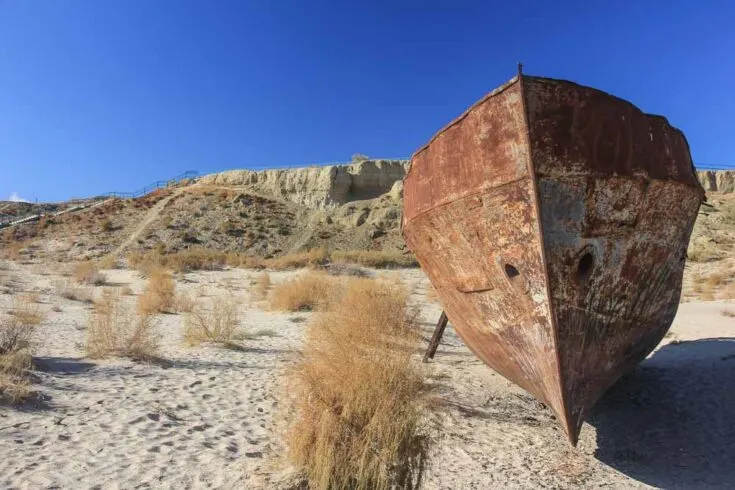
What Is the Aral Sea Crisis?
Back until the 1960s, the Aral Sea was the world’s fourth-largest body of freshwater – in fact, it was as large as Ireland.
Despite its name, the Aral Sea was not an actual sea. Instead, it was an enormous lake that held a salinity of 10 grams of salt per liter.
Oceans, on the other hand, have around 35 grams of salt per liter.

Nowadays, the remains of the Aral Sea is not more than 6 or 7% of its original size because of environmental degradation, and probably the worst human-made disaster in history.
The drying of the Aral Sea has ravaged big parts of the Central Asian region with diseases, birth defects, agricultural and economic devastation. Even today, so are this part of the world suffering.
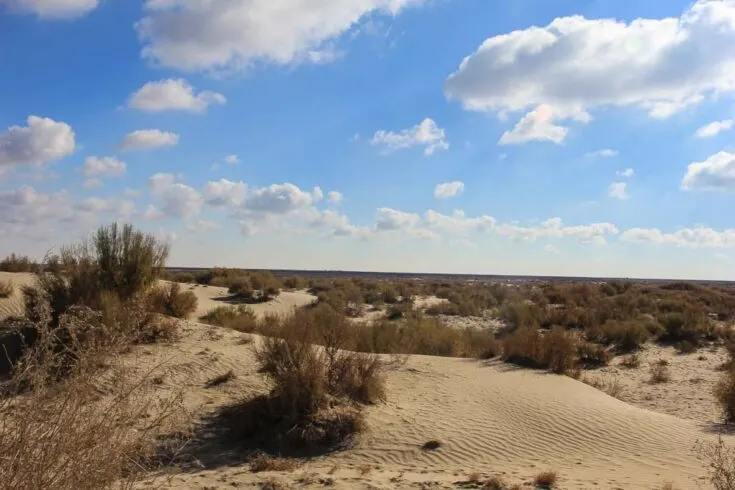
Everything that was once built around the Aral Sea is now deserted and left behind in the middle of Moynaq.
It once became a popular holiday destination in the old Soviet, with its beaches, seaside restaurants with fresh seafood, and hotels. But these days, you will only see the ruins of the former glory.

Moynaq is genuinely a depressing place, but still worth a visit if you are in Central Asia.
To sustain the economy and create even more fertile lands, the Soviet Union created an irrigation system that led the river down to crops and cotton fields which is everywhere in the area everywhere (one of the main reason the Aral Sea have disappeared)
Now the waters no longer remained in a deep depression; they instead flowed to thousands of miles of plantations – specifically cotton.
In 1960, fishing villages were scattered across the shores, and local towns thrived in the area. Yet, the lake was not looking in good shape. Something led to this glorious body of water turning into a body of toxic remains.
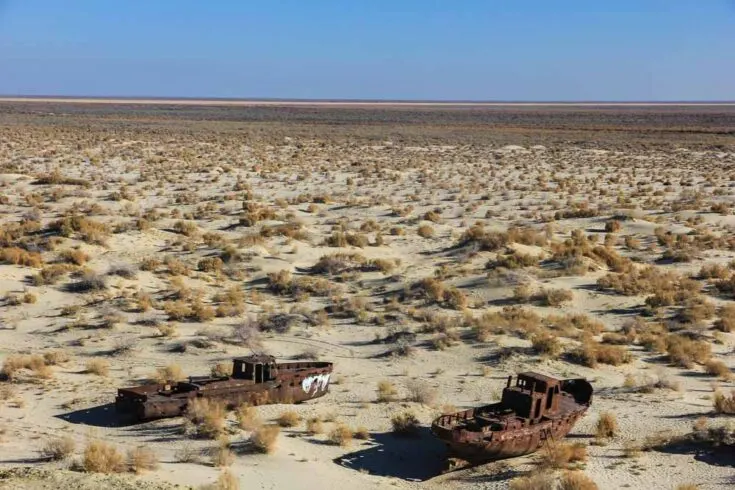
By 1980 the banks were replaced by deserts, and the islands on the lake that were used for the military and weapons development merged into the landscapes.
This led to deserted ships populating the land.
DDT, Focalin, pesticides, and high quantities of salt dried on the pans – some of which are known to cause cancer and other debilitating illnesses.
And because the sand wasn’t solid, dust swept across the region, poisoning the crops of struggling farmers and those living in poverty due to the lake and their livelihood drying up. There´s now a monument where the shoreline used to be.
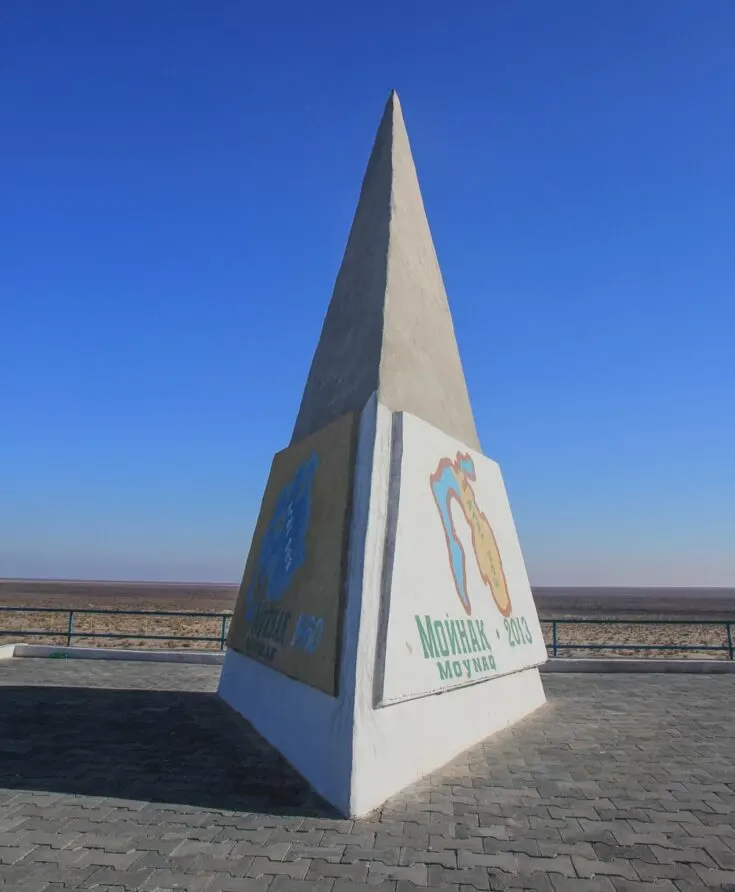
The lake was dumped with so much waste from the bioweapons labs that now the region is one of the deadliest in the world. So deadly that it has one of the highest infant mortality rates.
There are a lot of beautiful places in the world, but most of them are already overcrowded with crowds of tourists. So what to do to escape the crowds? Visit one of the worst sites in the world.
The Aral Sea, or what’s left of it, is definitely not a beautiful place.
It’s one of the biggest disasters that humankind has left behind so far.
Visiting the Aral Sea can be considered to be a Dark Tourism site.
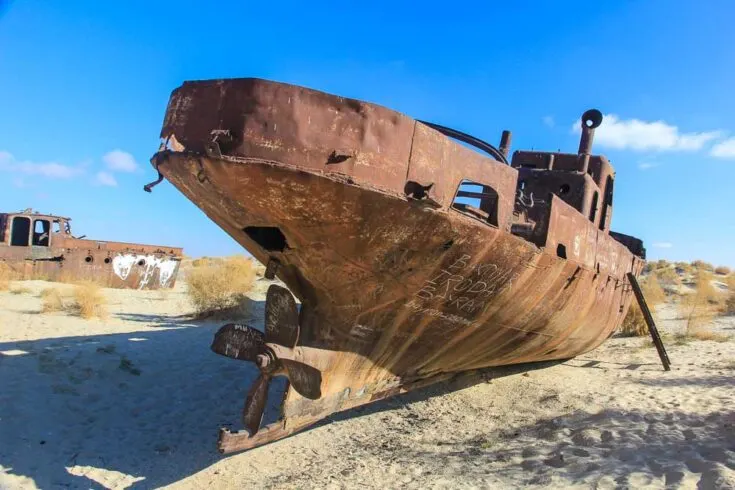
Where Is the Aral Sea?
In the wilds of central Asia, sitting alongside the borders of Kazakhstan and Uzbekistan, are the remains of the Aral Sea.
The lake is mostly dried up in the Uzbekistan region, yet bodies of water are still present on the Kazak side and over the recent years started to slowly increase again.
Getting to the Aral Sea Crisis
Getting to the Aral Sea is an adventure in itself. Expect to be traveling along dirt roads for a couple of hours.
To start the journey, you’ll need to arrive at Nukus from the Uzbek side. Nukus has a small airport with limited flights that arrive from Moscow or Tashkent.
Flights usually only come weekly, and it’s best to plan ahead so that you don’t get stranded for a couple of days.
Moynaq is the best place to experience the Aral Sea. There are bus trips and train rides that leave from Nuku to Moynaq. However, you can’t always rely on their schedules.
I ended up taking a taxi with the locals through to Moynaq, which is always great on adventures.
Taxis are usually around US $70.


Driving from Nuku to Moynaq is around 200 km (3 – 3½ hr one way). The route shows off miles of cotton fields, but the further along you travel, the more spooky and deserted the landscape becomes.
There´s also possible to do a long day trip from Khiva to Moynaq, which most guesthouses and hotels in Khiva can arrange, except to pay around 150/200$ for the trip, which can be shared among for people.
But be aware it´s 370km and around 5 hours each way, so you will have to start around 5 am from Khiva to be able to do the long 740km trip in a day.
Soon the only thing you’ll end up seeing is abandoned factories and fishing boats.
Top tip: If you do find yourself stuck in Nuku for a couple of hours, embrace the unusual traveler within you and visit attractions like the famous Igor Savitsky Museum that houses 82,000 items, ranging from antiquities from Khorezm to Karakalpak folk art, Uzbek fine art, and, uniquely, the second largest collection of Soviet and Russian art in the world after the collection at The Russian State Museum in Saint Petersburg.

Jeep Tour From Nukus
The Aral Sea is located in a very remote region, where you definitely won’t be seeing much signage, and a 4WD vehicle is required, as there aren’t proper roads either.
Getting lost in this area isn’t something you want to happen (because the Aral Sea map isn’t accurate enough), so going with someone who has extensive knowledge is a must.
People often arrive at Nukus to embark on a Jeep tour to Moynaq that takes care of all the logistics. Plus, it’s heaps of fun and not your typical over-the-top touristy experience.
Jeeps hold four people, so you can opt to do the tour solo or with some friends.
One of the coolest parts of the Jeep tours is that you often have the chance to spend the night camping under the stars.
Depending on how kitted out you are, you can rent equipment from the tour camping or bring along your own.
Be warned, temperatures deep within the Aral Sea range from -40°C to 40°C.
Nights can be bone-chilling, which you might not expect while you’re sweating throughout the day.
Psst… Before you come across as a stuck-up traveler, keep in mind that it’s common to share meals with your guide.
What to Do at the Aral Sea Environmental Catastrophe
The eerie scene of Moynaq is the biggest appeal of traveling to this remote region.
Once a wealthy town populated with fishing villages, Moynaq is a ghost town, and adventures are scarce.
Even though there isn’t much to do, you can still spend four or five hours wandering around the abandoned town, climbing the ships, or discovering Moynaq and the Aral Sea’s history.
But be aware there´s nowhere to get money in Moynaq but to be honest. There´s nothing to spend money on in Moynaq anyway.
Ship Cemetery
A ship cemetery is located below the lighthouse. The rusting hulks lay abandoned with no water in sight, many of them overgrown with shrubs.
Near the lighthouse, you’ll find a board with information about the old fish cannery and the history of these fleets.
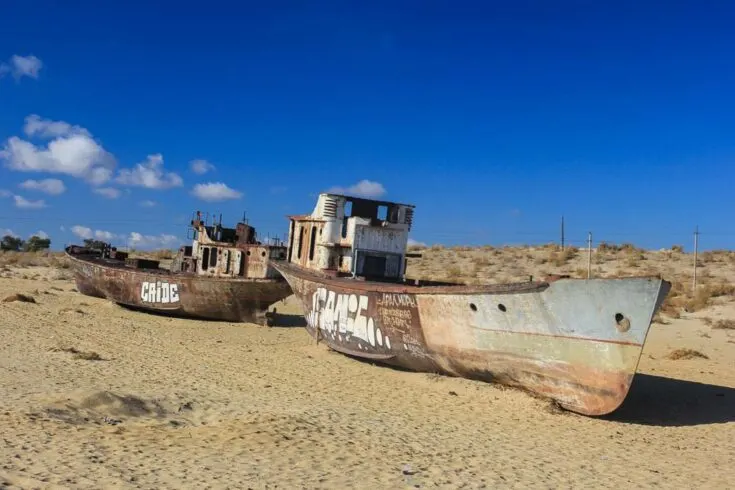
If you walk further down from the ships, you’ll notice a few small beaches.
The locals use boats and canoes to fish and collect grasses from the wetlands to feed their livestock.
Discover the Landscape of the Aral Sea
It’s been dry for so long that the only vegetation to be seen is fields of sage bushes which soon disappear into arid sandy soil. Amongst the sandy floors lies thousands of seashells.
It might seem completely strange, but you’ve got to remember that this was once a flourishing body of water.
Moynaq Museum
Visiting the small Moynaq Museum is one of the only ‘touristy’ things to do. On the ground floor, you can explore the ruins of a fish factory and discover the region’s history.
The top floor boasts paintings of what Moynaq used to look like in the early to mid-1900s.


Accommodation Near the Aral Sea
When it comes to visiting the Aral Sea, travelers have the option of roughing it up and camping near the abandoned wasteland or staying in Nukus or do a very long day trip from Khiva.
While it´s supposed to be 1 hotel on Moynaq so does it seems to have been closed for years.
Staying in Nukus still means that you’re in reach of the prominent lake by embarking on day trips or speaking to the concierge about tips and tricks to discovering the surrounding areas.
- Camping: Unusual travelers are enchanted with the eerie nature of the Aral Sea. Many choose to set up camp and spend the night under the milky way. If you have your own transport and camping supplies, this couldn’t be more of an off-the-beaten-path adventure in Uzbekistan.
- Book a stay in Nukus: Staying in Moynaq isn’t a viable option because of how far out it is, on top of the lack of reliable accommodation. Hotel Jipek Joli and Tashkent Hotel are your best bets for a comfortable stay in Nukus. They both cater to budget and luxury-driven travelers and have great on-site restaurants.
Aral Sea Pollution: Is It Safe To Visit?
There’s no denying that the Aral Sea problems, like drying out and weapons waste being dumped in the waters, have had detrimental effects.
Specifically long-term health effects and destruction of resources.

However, visiting the toxic shores for short periods isn’t going to cause you any harm.
Swimming in the swampy waters is a no-go, and so is drinking from the lake’s remnants.
In terms of general safety, you’re in good hands. It’s not a dangerous place to visit.
But you do need to remember that people live in extreme poverty here due to the Aral Lake drying up and destroying their resources. You might encounter some aggressive beggars and some hungry stray dogs roaming around.
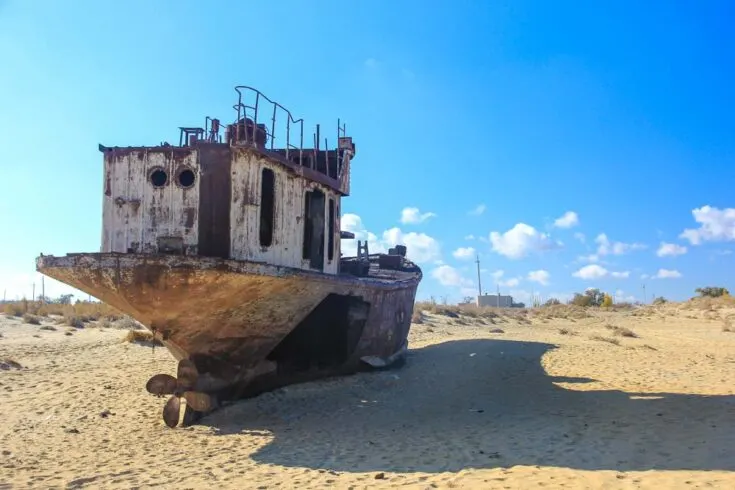
Overall Experience of Visiting the Aral Sea
It’s hard to imagine that the Aral Sea was once a lake bursting with life.
Yet today, the area is so dry and dusty because there isn’t enough moisture coming in.
This is an issue we all need to think about: how do we preserve our natural resources for future generations? Maybe someday the Aral Sea will be as big as it used to be – or maybe not.

As for now, the most adventurous of travelers can discover the Aral Sea – which has shrunk to 10% of its original size.
From Jeep tours in the forgotten lands to camping under a blanket of stars, seeing this disaster in person is sure to be an experience, unlike many others.
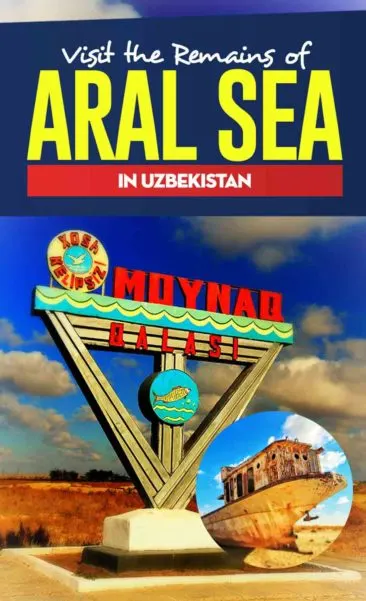

Annie Berger
Saturday 24th of July 2021
Enjoyed this post specifically because my husband and I were in Khiva a few years ago and had hoped to get up to Moynaq and see the Aral Sea. My husband wasn't as 'excited' as I to want to spend all that time in a jeep just to see rusted-out boats, though. Glad to finally see them through your lens.
Magalie
Sunday 6th of May 2018
So you would'nt recommend this, I am on a limited budget and only spending 10 days in uzbekitstan.
Christian L.
Sunday 6th of May 2018
for 10 days can you easily visit the Aral Sea, just go to Khiva and meet some other travelers there that you can split the price with
mariko
Monday 5th of September 2016
wow. Your photos paint a beautiful picture of a desolate place. PS.. .your twitter counter actually counts tweets!?
An 18 Year Old Guy Left School for Him to Get Back to his Wanderlust and See the World – World Trending News
Wednesday 9th of March 2016
[…] Source: unusualtraveler.com […]
David
Thursday 19th of November 2015
Nice photos!